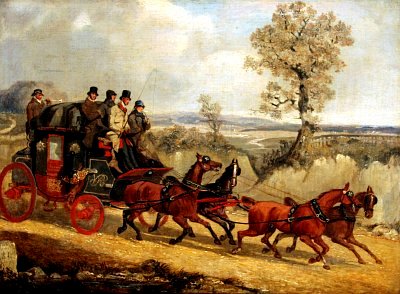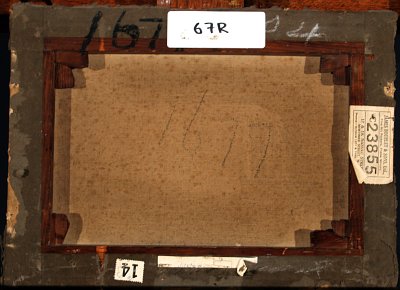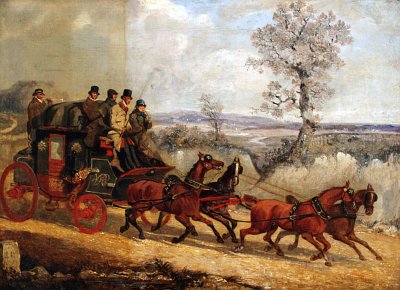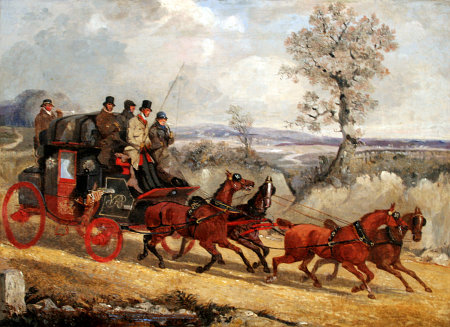|
Henry Alken, Snr
(1785 - 1850)
Title: The Dover Coach
Technique: Oil on canvas
Signature: not present
Dimensions: 27 x 37 cm
Frame: Wooden, gesso moulded, gilded gold
Treatment: October – December 2006
CONDITION REPORT
SECONDARY SUPPORT: This is a 4 member stretcher and 7 of the original 8 keys are present. It appears to be in a sound condition. This may not be the original stretcher as the canvas has been previously lined. The following inscriptions can be read:
James Bourlet & Sons, Ltd.,
Fine Art Packers, Frame Maker
C 23863
17 & 18, Nassau Street,
Mortimer Street, W.
Phone;- Museum 1817 & 7588
This label is seen on right-hand side; it is on fine pulp paper with black ink print.
A second label reads “14” on the bottom. This label has perforated edges.
PRIMARY SUPPORT: The primary support is a medium-weight tabby weave canvas. The tacking margins have been removed and the edges have not been evenly cut. The lining canvas appears a lighter weight and the tacking margin is 11mm in width. The condition of both the primary and lining canvas appear to be in a sound condition. Tacks have been evenly used and these appear to be slightly rusty.
GROUND: The ground is cream in colour. On the left-hand side the canvas was cut to expose the edge showing it to be commercially prepared. The condition is sound.
PAINT LAYER: The artist has applied his paint thinly. Extensive over-paint covers the work covering an overall drying crack pattern with some age-cracks as well.
VARNISH LAYER: The natural resin varnish layer is discoloured and a layer of surface dirt covers this. This is not the original varnish. Under UV light it appears to be thickly applied, masking the image. The retouchings do not appear separately.
TREATMENT CARRIED OUT
A photographic record was taken and this was maintained throughout the treatment.
Tests were carried out to remove the surface dirt. Once the appropriate reagent was identified, removal of the surface dirt was carried out.
Following tests including a safety margin-cleaning test, an organic solvent was used to remove the discoloured varnish layer safely and effectively. Cleaning proceeded using a swab stick.
The over-paint covering the extensive drying crack pattern could not be removed separately from the varnish removal.
Dirt was removed from between the canvas and the stretcher bar. The stretcher was cleaned and waxed and the back of the canvas cleaned.
An isolating brush conservation varnish was applied. Losses were retouched and a final varnish applied.
The frame was cleaned, small losses retouched and the painting secured using brass plates.
|
|

Whole front, before treatment
|

Whole back, before treatment
|

Whole front, during surface dirt and varnish removal
|

Whole front, after treatment
|
|




